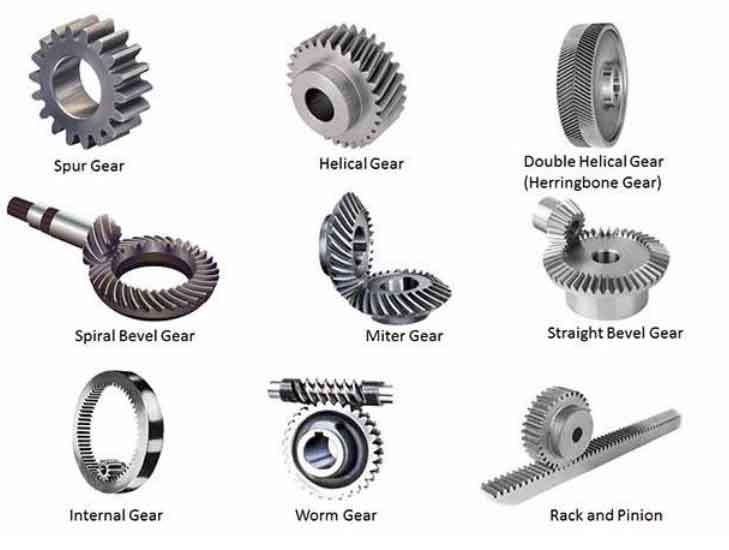Bevel gears and spiral gears are two common types of gears used in various mechanical systems. Both gear types have their unique characteristics and applications. Let’s compare them based on several key factors:

- Tooth Engagement:
- Bevel Gears: Bevel gears have straight-cut teeth that engage abruptly, resulting in higher noise and vibration levels. They produce more impact and are typically noisier than other gear types.
- Spiral Gears: Spiral gears have helical teeth that engage gradually, offering smoother and quieter operation. The inclined teeth allow gradual tooth engagement, reducing noise and vibration significantly.
- Load Capacity:
- Bevel Gears: Bevel gears can handle higher loads and torque due to their larger tooth contact area. They are commonly used in heavy-duty applications that require high power transmission.
- Spiral Gears: Spiral gears have a lower tooth contact area compared to bevel gears, which may limit their load-carrying capacity. They are generally used in applications with moderate loads.
- Efficiency:
- Bevel Gears: Bevel gears provide relatively lower efficiency due to their straight-cut teeth and greater sliding friction during tooth engagement.
- Spiral Gears: Spiral gears offer higher efficiency compared to bevel gears due to their helical teeth, which enable smoother engagement and reduce sliding friction.
- Axial Thrust:
- Bevel Gears: Bevel gears generate axial thrust forces during operation, which can be significant. Proper thrust management, such as using thrust bearings, is necessary to handle these forces.
- Spiral Gears: Spiral gears produce less axial thrust compared to bevel gears due to the helical teeth design. This reduces the need for additional thrust management.
- Misalignment Compensation:
- Bevel Gears: Bevel gears are less tolerant of misalignment between the driving and driven shafts. Misalignment can cause increased wear and noise in bevel gears.
- Spiral Gears: Spiral gears offer better misalignment compensation due to their helical teeth, which can accommodate a certain degree of misalignment without significant adverse effects.
- Cost and Manufacturing Complexity:
- Bevel Gears: Bevel gears are generally less complex to manufacture and can be more cost-effective compared to spiral gears.
- Spiral Gears: Spiral gears have a more complex manufacturing process due to their helical teeth, resulting in higher production costs.
- Lubrication and Maintenance:
- Bevel Gears: Bevel gears often require adequate lubrication to minimize wear and prevent overheating. Maintenance may involve regular lubrication and inspection to ensure proper functioning.
- Spiral Gears: Spiral gears generally have better lubrication characteristics due to the helical tooth design. The continuous tooth engagement helps distribute lubricant more evenly, reducing the need for frequent lubrication and maintenance.
- Torque Transmission:
- Bevel Gears: Bevel gears are efficient in transmitting torque between intersecting shafts at right angles. They are commonly used in applications such as differential drives and right-angle gearboxes.
- Spiral Gears: Spiral gears are suitable for transmitting torque between parallel or slightly offset shafts. They are often found in automotive transmissions and industrial machinery.
- Space and Design Constraints:
- Bevel Gears: Bevel gears require more space due to their larger size and tooth contact area. They may not be suitable for compact designs or applications with limited space.
- Spiral Gears: Spiral gears can be more compact compared to bevel gears, making them suitable for applications where space is limited or a smaller form factor is desired.
- Manufacturing Precision:
- Bevel Gears: Bevel gears can be manufactured with relatively less precision compared to spiral gears. This can be advantageous in certain applications where high precision is not critical.
- Spiral Gears: Spiral gears require higher manufacturing precision due to the helical tooth design, ensuring proper tooth engagement and smooth operation.
- Applications:
- Bevel Gears: Bevel gears find applications in various industries, including automotive, aerospace, marine, and heavy machinery. They are commonly used in differential drives, power transmission systems, and steering mechanisms.
- Spiral Gears: Spiral gears are widely used in automotive transmissions, industrial machinery, and gearboxes that require smooth and quiet operation, such as conveyors and robotics.
In summary, bevel gears are often preferred for heavy-duty applications requiring high torque and load capacity. They are suitable when noise and efficiency are not critical factors. Spiral gears, on the other hand, offer smoother operation, reduced noise, higher efficiency, and better misalignment compensation. They are commonly used in applications where noise, vibration, and efficiency are important considerations. The choice between bevel gears and spiral gears depends on the specific requirements and constraints of the application at hand.
